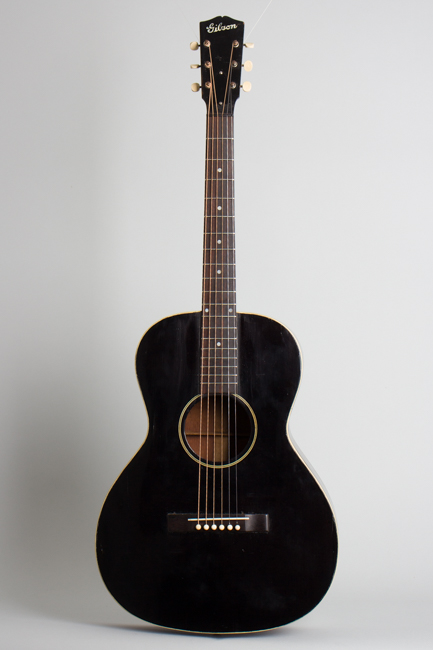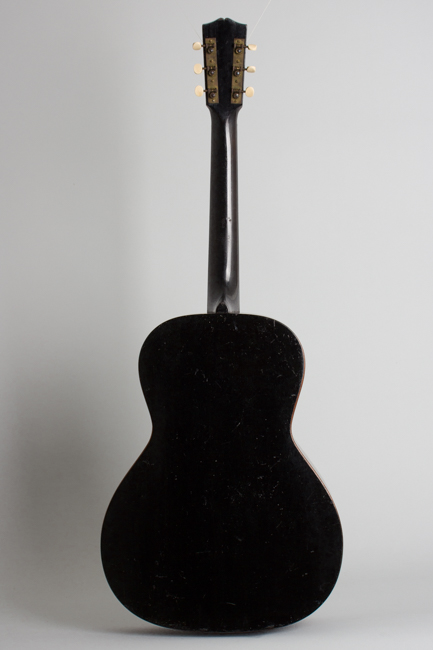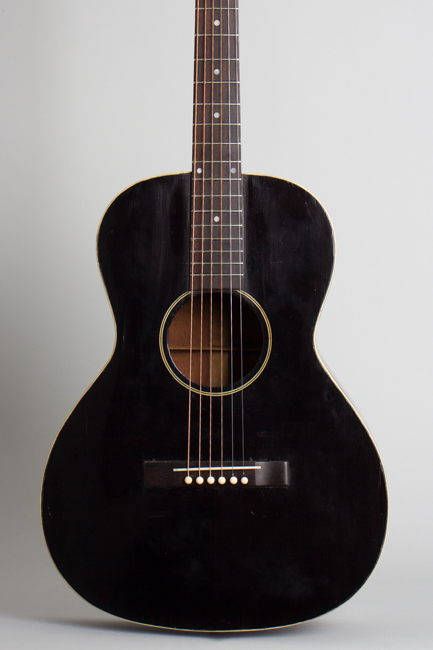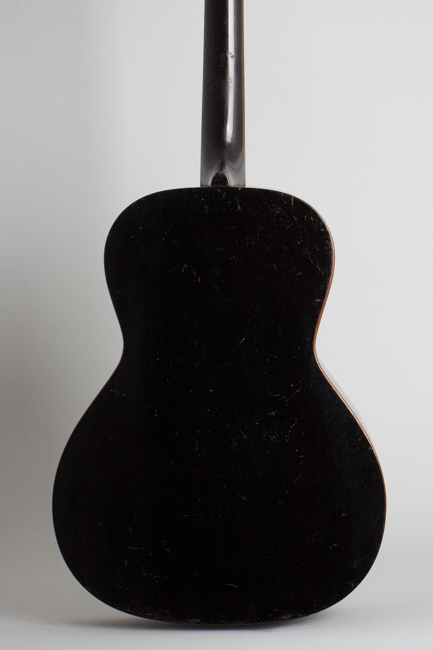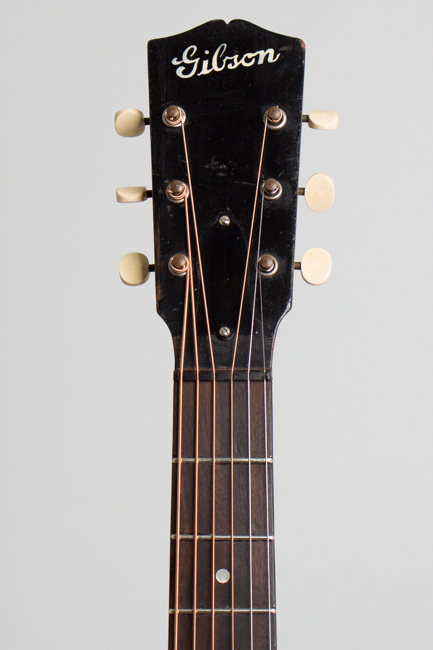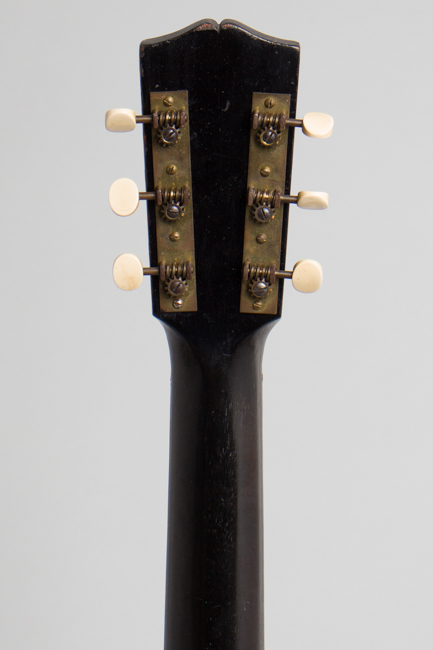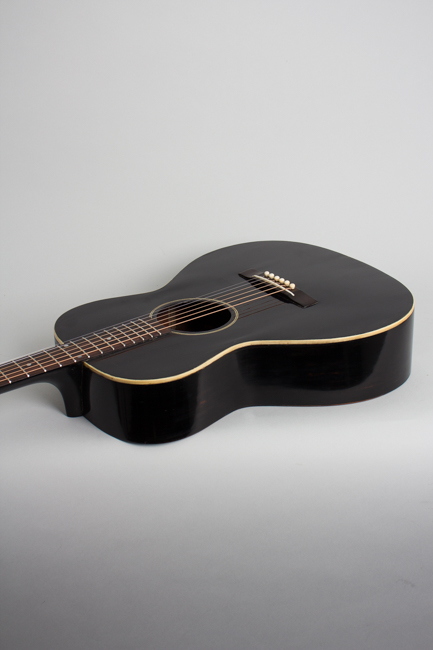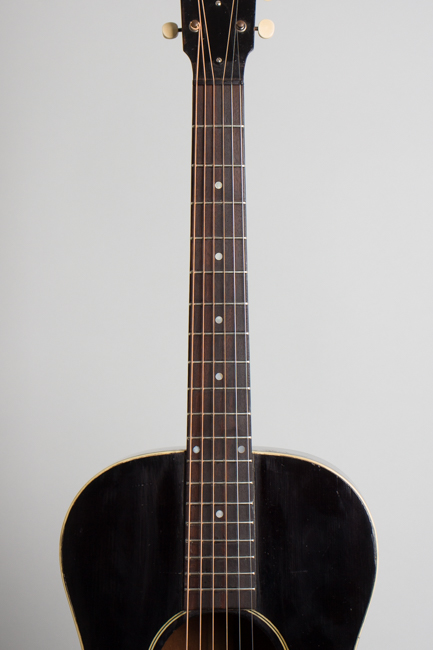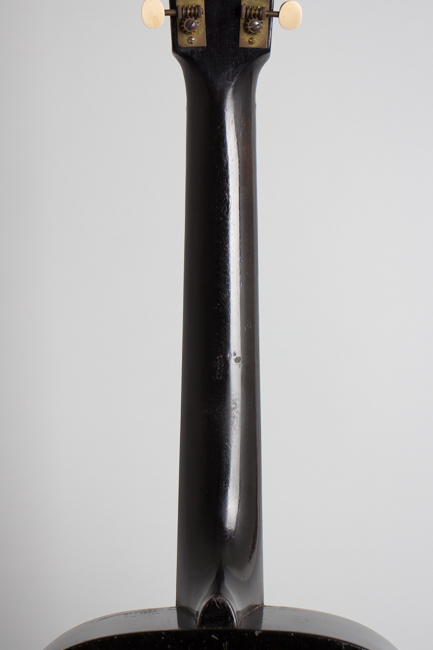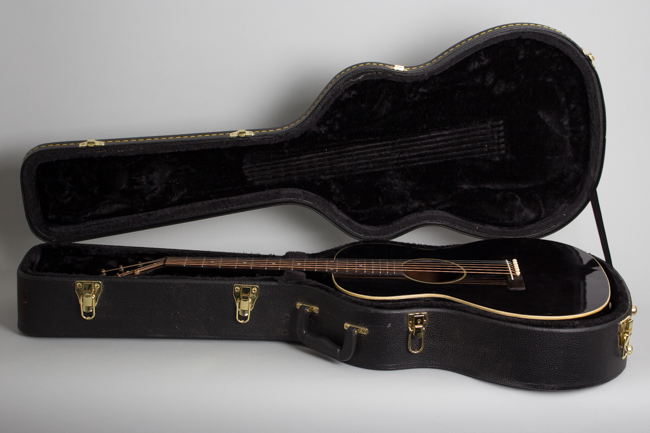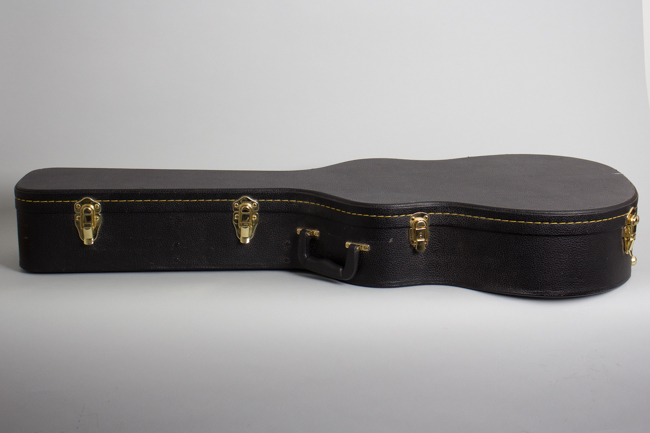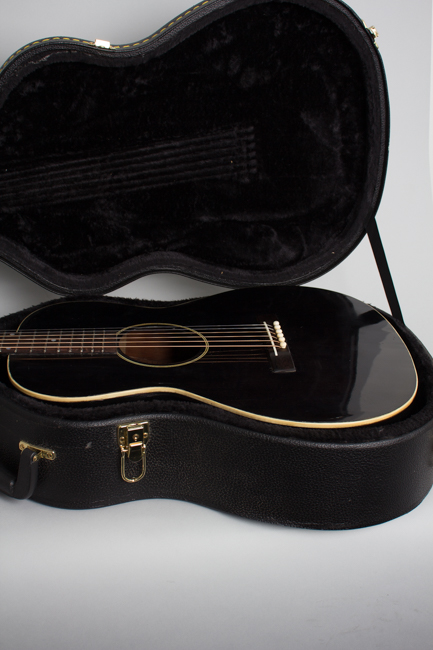Gibson L-00 Flat Top Acoustic Guitar (1931)
This item has been sold.
Item # 11408
Prices subject to change without notice.
Gibson L-00 Model Flat Top Acoustic Guitar (1931), made in Kalamazoo, Michigan, serial # 139, black lacquer finish, mahogany back, sides and neck; spruce top, rosewood fingerboard, black hard shell case.
This is a good playing example of a very early 12-fret Gibson L-00 from 1931, the very rare initial version of this seminal Gibson flat-top. It is a plain but striking guitar, finished in ebony overall with white binding around the top and no pickguard. The L-00 quickly became a Depression-era staple for Gibson, first offered this year at the rock-bottom price of $25.00 (without case). The factory order number on the heelblock documents this as being from one of the first batches of L-00s made, dating to a year or so before the instrument was re-designed into the more familiar 14-fret version sold up until WWII.
This is a very plainly-ornamented guitar with a white script stenciled "Gibson" logo, single-bound spruce top, and 3-ply sound hole ring; still, the black-and-white cosmetics give it a very striking "tuxedo" look. The bracing is a VERY thin X pattern, and the neck is a slim and surprisingly modern feeling "C" profile, not the deep "V" that would be adopted a year or so later. This is a much more comfortable neck for most modern players, but was a relatively short-lived feature on this model. It actually joins the body at the 11 1/2 fret position, a short-lived Gibson quirk. Apart from this oddity this first L-00 is broadly similar to Gibson's period budget "Kel Kroydon" models, but with the useful addition of the company's adjustable truss rod and the striking ebony livery.
The L-00 model subsequently went through several design changes in a short period of time in the early 1930s; this is pretty much our favorite version, an extremely light and responsive guitar, super sharp-looking, and a fabulous fingerpicker. These were built in fairly limited numbers, as production of this version of the model coincided with the worst years of the Depression when even $25 was beyond the reach of many Americans. This one has seen some repair work but due to their relative fragility few survive as nicely as this one, which with some careful restoration remains an excellent player's instrument.
Overall length is 38 1/4 in. (97.2 cm.), 14 3/4 in. (37.5 cm.) wide at lower bout, and 4 11/16 in. (11.9 cm.) in depth at side, taken at the end block. Scale length is 24 3/4 in. (629 mm.). Width of nut is 1 3/4 in. (44 mm.).
This guitar shows some light general wear, but has gone through what appears to be more than one bout of restoration to keep it in top playing condition. The bridge is a modern replacement by Fraulini guitars builder Todd Cambio, as is the correct style small maple bridgeplate. It has a couple of tiny chips off the pins and there is some scarring around it. Internally some of the braces have been reglued solidly but visibly; it looks like this was done a long time ago. The top was oversprayed when the bridge work was done, so it has a somewhat shinier patina than the rest of the instrument. The back finish is otherwise original with some small touchups; the sides look to have had some overspray and polish out some time ago as does the back of the neck.
The neck was reset at some point, the fingerboard trued and refretted with period appropriate wire showing little subsequent wear. The top shows a few very minor old sealed grain splits around the edges under the overfinish but no major cracks, fairly unusual for one of these. These are in the upper waist area, and one just at the edge on the curve of the lower treble bout; all are inconspicuous. The crucial area around the bridge is completely solid.
The headstock finish remains original, as does the ebony nut. The original unplated strip tuners with black buttons are in good shape and work as well as they ever did. This is a fine playing and sounding example of this fairly rare guitar, and even with some fairly extensive restoration better preserved than many. It is a fine blues machine, and beyond that a fairly versatile all-around flat-top guitar equipped with a modern HSC. Overall Excellent - Condition.
This is a good playing example of a very early 12-fret Gibson L-00 from 1931, the very rare initial version of this seminal Gibson flat-top. It is a plain but striking guitar, finished in ebony overall with white binding around the top and no pickguard. The L-00 quickly became a Depression-era staple for Gibson, first offered this year at the rock-bottom price of $25.00 (without case). The factory order number on the heelblock documents this as being from one of the first batches of L-00s made, dating to a year or so before the instrument was re-designed into the more familiar 14-fret version sold up until WWII.
This is a very plainly-ornamented guitar with a white script stenciled "Gibson" logo, single-bound spruce top, and 3-ply sound hole ring; still, the black-and-white cosmetics give it a very striking "tuxedo" look. The bracing is a VERY thin X pattern, and the neck is a slim and surprisingly modern feeling "C" profile, not the deep "V" that would be adopted a year or so later. This is a much more comfortable neck for most modern players, but was a relatively short-lived feature on this model. It actually joins the body at the 11 1/2 fret position, a short-lived Gibson quirk. Apart from this oddity this first L-00 is broadly similar to Gibson's period budget "Kel Kroydon" models, but with the useful addition of the company's adjustable truss rod and the striking ebony livery.
The L-00 model subsequently went through several design changes in a short period of time in the early 1930s; this is pretty much our favorite version, an extremely light and responsive guitar, super sharp-looking, and a fabulous fingerpicker. These were built in fairly limited numbers, as production of this version of the model coincided with the worst years of the Depression when even $25 was beyond the reach of many Americans. This one has seen some repair work but due to their relative fragility few survive as nicely as this one, which with some careful restoration remains an excellent player's instrument.
Overall length is 38 1/4 in. (97.2 cm.), 14 3/4 in. (37.5 cm.) wide at lower bout, and 4 11/16 in. (11.9 cm.) in depth at side, taken at the end block. Scale length is 24 3/4 in. (629 mm.). Width of nut is 1 3/4 in. (44 mm.).
This guitar shows some light general wear, but has gone through what appears to be more than one bout of restoration to keep it in top playing condition. The bridge is a modern replacement by Fraulini guitars builder Todd Cambio, as is the correct style small maple bridgeplate. It has a couple of tiny chips off the pins and there is some scarring around it. Internally some of the braces have been reglued solidly but visibly; it looks like this was done a long time ago. The top was oversprayed when the bridge work was done, so it has a somewhat shinier patina than the rest of the instrument. The back finish is otherwise original with some small touchups; the sides look to have had some overspray and polish out some time ago as does the back of the neck.
The neck was reset at some point, the fingerboard trued and refretted with period appropriate wire showing little subsequent wear. The top shows a few very minor old sealed grain splits around the edges under the overfinish but no major cracks, fairly unusual for one of these. These are in the upper waist area, and one just at the edge on the curve of the lower treble bout; all are inconspicuous. The crucial area around the bridge is completely solid.
The headstock finish remains original, as does the ebony nut. The original unplated strip tuners with black buttons are in good shape and work as well as they ever did. This is a fine playing and sounding example of this fairly rare guitar, and even with some fairly extensive restoration better preserved than many. It is a fine blues machine, and beyond that a fairly versatile all-around flat-top guitar equipped with a modern HSC. Overall Excellent - Condition.
